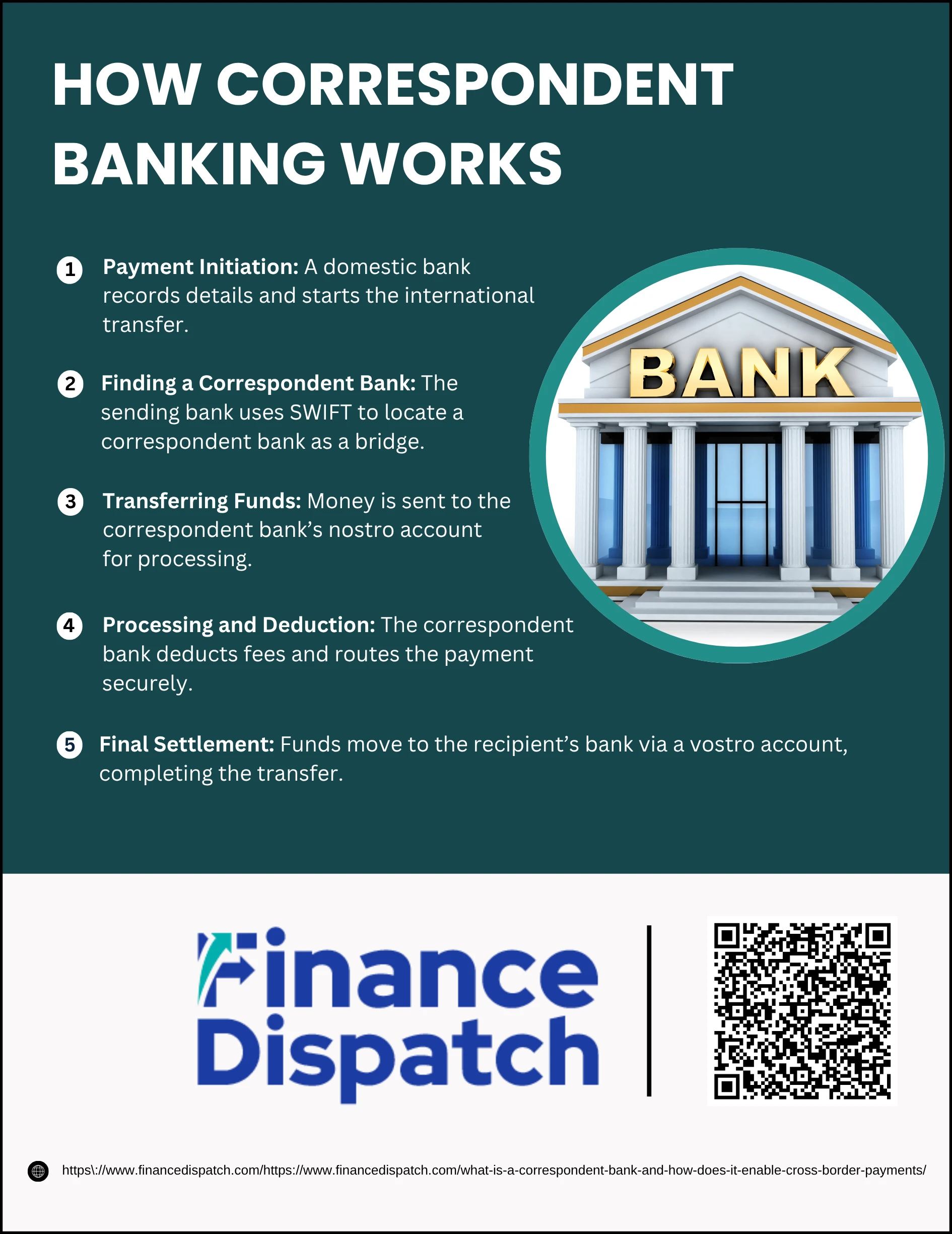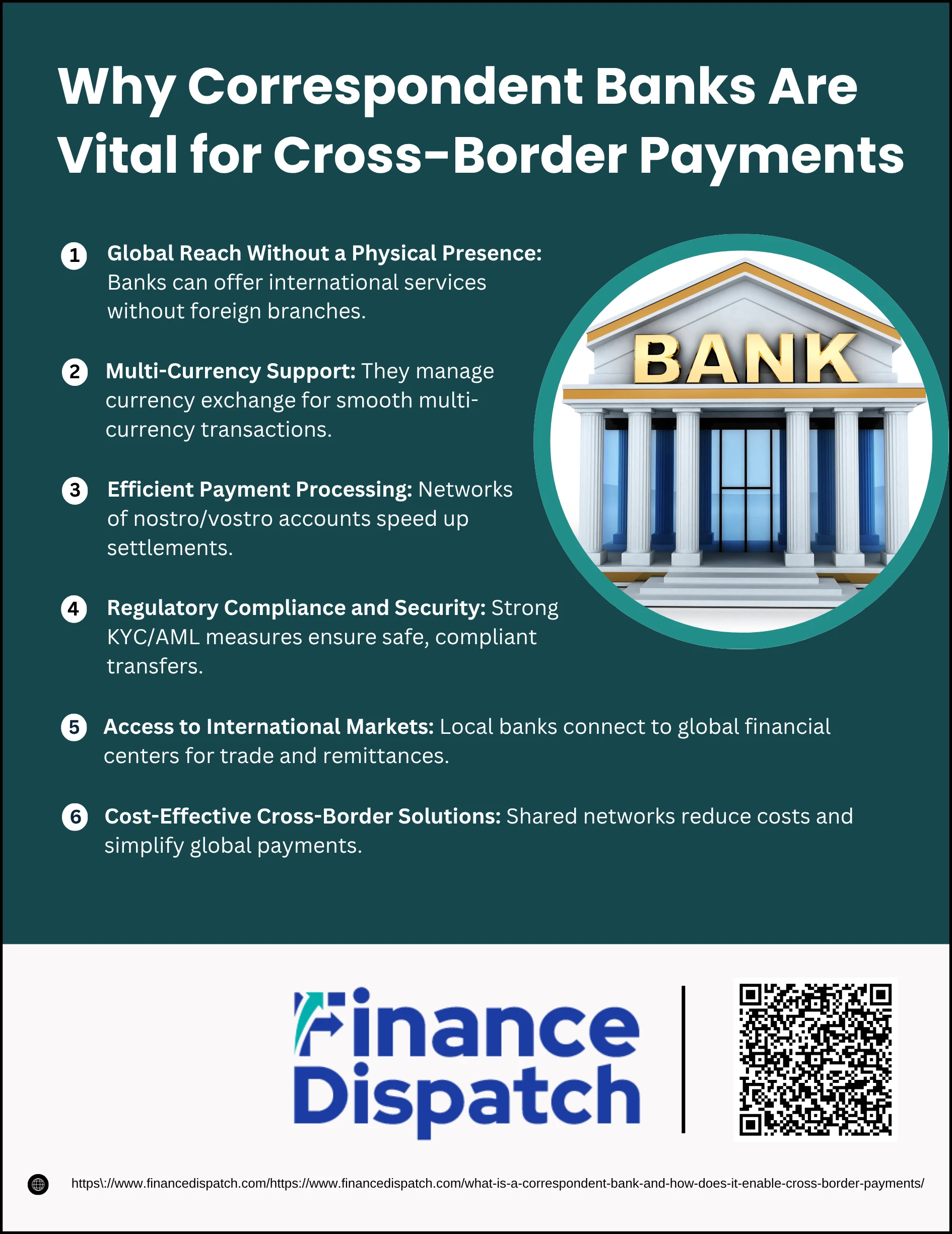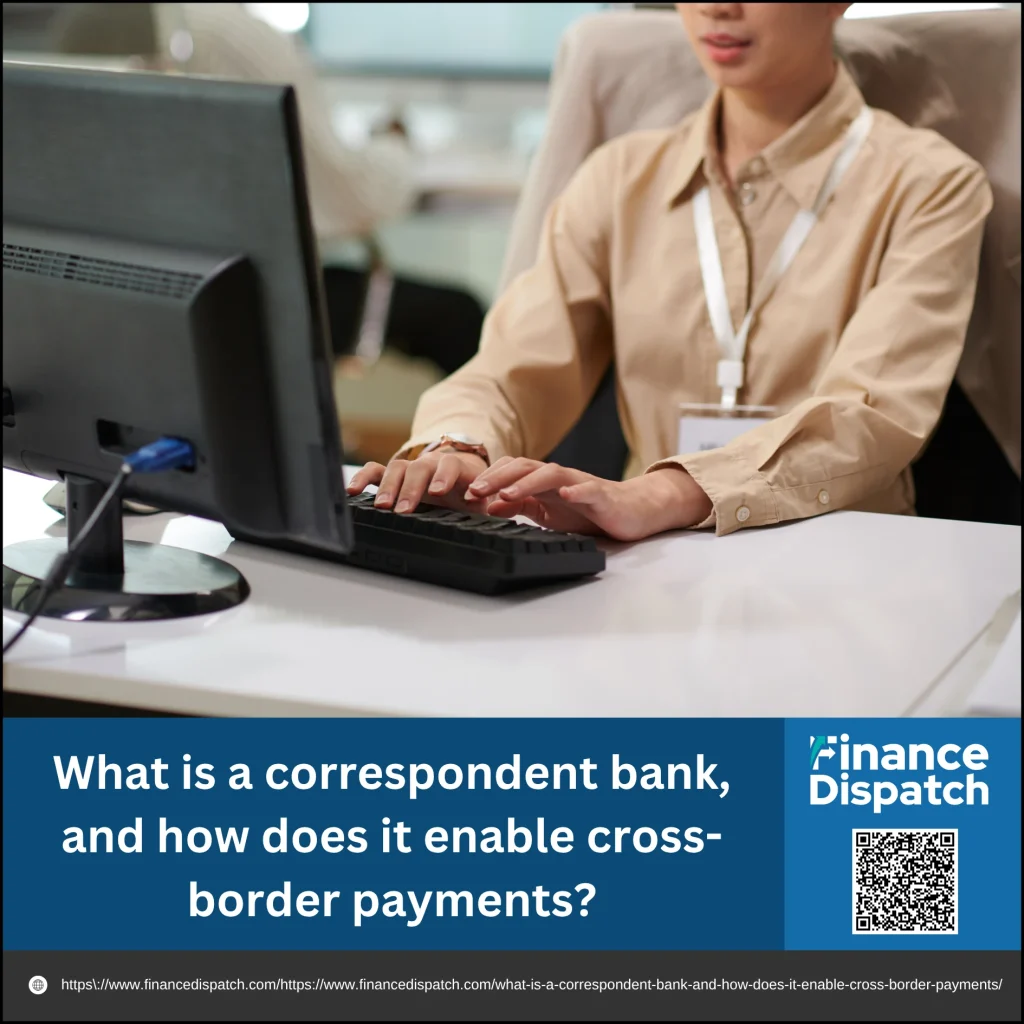In today’s interconnected global economy, money often travels farther and faster than people do. Whether a business in the United States is paying a supplier in Japan or an individual is sending funds to family overseas, these transactions depend on a complex web of financial institutions working seamlessly behind the scenes. At the heart of this network lies the correspondent bank—a third-party financial institution that bridges the gap between banks in different countries. Without correspondent banks, most cross-border payments and international trade would slow to a crawl, as few banks maintain direct relationships worldwide. By facilitating fund transfers, currency exchange, and settlement between distant institutions, correspondent banks quietly ensure that global commerce runs smoothly every single day.
What is a Correspondent Bank?
A correspondent bank is a financial institution that acts as an intermediary between domestic and foreign banks to facilitate international transactions. It serves as a bridge that enables banks to provide cross-border services—such as wire transfers, check clearing, trade financing, and currency exchange—without maintaining a physical presence in another country. For instance, if a small bank in Nepal needs to send money to a supplier’s bank in Germany but lacks a direct relationship, it can rely on a correspondent bank that holds accounts with both institutions to complete the transfer. In this way, correspondent banks allow local and regional banks to access the global financial system, making international payments faster, safer, and more efficient for businesses and individuals alike
 How Correspondent Banking Works
How Correspondent Banking Works
Correspondent banking forms the backbone of international money movement. When two banks located in different countries lack a direct relationship, a correspondent bank steps in to ensure the transaction happens smoothly. Acting as a trusted intermediary, the correspondent bank uses global communication systems like SWIFT (Society for Worldwide Interbank Financial Telecommunication) to connect the sender and receiver’s banks. This process ensures that payments, trade settlements, and currency exchanges are executed accurately and securely, even across different time zones and regulatory frameworks.
Here’s a step-by-step explanation of how the process unfolds:
1. Payment Initiation
The process begins when a customer at a domestic bank requests to send money to a recipient in another country. This could be for trade payments, remittances, or any other cross-border transaction. The domestic bank (often called the originating or sending bank) records the details—such as the recipient’s name, bank, and currency—and initiates the transfer.
2. Finding a Correspondent Bank
If the domestic bank doesn’t have a direct relationship with the recipient’s foreign bank, it needs a middleman. Using the SWIFT network, which connects more than 11,000 financial institutions worldwide, the sending bank identifies a correspondent bank that already has established accounts and relationships with both sides. This correspondent bank acts as the bridge that allows money to move between the two banks securely.
3. Transferring Funds
Once the correspondent bank is identified, the domestic bank transfers the required amount to its nostro account—which literally means “our account held by you”—at the correspondent bank. This step temporarily places the funds under the correspondent bank’s control, allowing it to process and forward the payment. The nostro account helps keep an accurate record of the sending bank’s foreign currency holdings.
4. Processing and Deduction
After receiving the transfer, the correspondent bank deducts a service fee, which typically ranges between $25 and $75 per international transaction. This fee covers operational costs and network access. Once the deduction is made, the correspondent bank processes the transaction by routing the payment through the appropriate clearing channels or systems in the destination country.
5. Final Settlement
The correspondent bank then transfers the remaining funds to the vostro account (“your account held by us”) of the recipient’s bank. From there, the receiving bank deposits the funds into the final beneficiary’s account. This marks the completion of the cross-border transaction. Both the sending and receiving banks can track these movements through the SWIFT message reference, ensuring transparency and accountability.
 Why Correspondent Banks Are Vital for Cross-Border Payments
Why Correspondent Banks Are Vital for Cross-Border Payments
In the global economy, money constantly moves between countries for trade, investments, remittances, and services. Yet, not all banks have direct connections with financial institutions overseas. This is where correspondent banks become indispensable. They act as the international link that enables funds to move securely between banks in different nations, ensuring that businesses and individuals can transact globally without delay. Correspondent banks provide access to foreign currencies, handle settlements, and maintain financial trust between institutions that might otherwise be disconnected.
1. Global Reach Without a Physical Presence
Correspondent banks allow smaller or domestic banks to offer international services without setting up branches or offices in foreign countries. This partnership opens access to the global financial system, enabling banks to process payments and serve clients across borders efficiently.
2. Multi-Currency Support
Cross-border transactions often involve currency conversion. Correspondent banks specialize in managing foreign exchange (FX), allowing smooth transfers between multiple currencies. This capability is crucial for international trade, where payments are frequently made in different denominations.
3. Efficient Payment Processing
By maintaining a network of nostro and vostro accounts, correspondent banks ensure that payments between institutions are settled quickly and accurately. Their established infrastructure reduces processing time and minimizes the complexity of handling international transactions.
4. Regulatory Compliance and Security
Correspondent banks operate under strict Know Your Customer (KYC) and Anti-Money Laundering (AML) regulations. Their robust compliance systems ensure that cross-border transactions meet global financial standards, providing security and reducing the risk of fraud or illicit activities.
5. Access to International Markets
Through correspondent banking relationships, even local banks can connect to major international financial centers. This access facilitates global trade, investments, and remittances, allowing businesses to expand operations and individuals to send or receive funds globally with confidence.
6. Cost-Effective Cross-Border Solutions
Instead of each bank establishing multiple direct relationships worldwide, correspondent banking offers a shared network model. This reduces operational expenses and simplifies transaction management while maintaining reliable, secure, and compliant international payment channels.
Correspondent Bank vs. Intermediary Bank
While both correspondent banks and intermediary banks act as third parties in cross-border transactions, their roles and relationships differ in scope and function. A correspondent bank maintains an ongoing partnership with other banks, providing a wide range of financial services such as foreign exchange, fund settlements, and trade financing across multiple currencies. In contrast, an intermediary bank typically steps in for one-time or occasional transactions, mainly to route payments when two banks lack a direct connection. Understanding their differences helps businesses and financial institutions choose the right pathway for international payments.
| Feature | Correspondent Bank | Intermediary Bank |
| Primary Role | Acts as a financial bridge between domestic and foreign banks, offering full-service support. | Serves as a temporary link to facilitate specific transactions between two unconnected banks. |
| Relationship Type | Long-term relationship with mutual accounts and continuous services. | Short-term or transaction-based involvement with no ongoing relationship. |
| Currency Handling | Manages multiple currencies and provides foreign exchange services. | Usually operates in a single currency, mainly for straightforward transfers. |
| Accounts Used | Maintains nostro and vostro accounts to track balances and settlements. | Typically does not maintain dedicated accounts with participating banks. |
| Range of Services | Offers wire transfers, currency exchange, trade finance, and clearing services. | Primarily focuses on routing international payments. |
| Example Scenario | A U.S. bank uses a German correspondent bank to send regular euro payments to European clients. | A Canadian bank uses a one-time intermediary in Europe to deliver a single payment to an African bank. |
| Network Reach | Has an extensive global network and established relationships across multiple financial systems. | Operates as a single link within a transaction chain, often part of a longer payment route. |
| Use Case | Best for banks and businesses requiring frequent and multi-currency cross-border operations. | Best for occasional transfers when no direct or correspondent relationship exists. |
Risks and Challenges in Correspondent Banking
Although correspondent banking plays a vital role in facilitating global payments, it also faces several risks and operational challenges. Because these transactions often involve multiple intermediaries and jurisdictions, they are exposed to regulatory scrutiny, compliance pressure, and financial risks. The very structure that enables global connectivity—reliance on third-party banks—can also make the system vulnerable to misuse, delays, and high costs if not properly managed. Understanding these challenges is crucial for maintaining transparency, trust, and efficiency in international banking.
Key risks and challenges include:
1. Money Laundering and Financial Crime
Correspondent banking relationships are often targeted by criminals who exploit cross-border systems to disguise illicit funds. Banks must implement robust Anti-Money Laundering (AML) and Countering the Financing of Terrorism (CFT) measures to detect suspicious activity.
2. Compliance and Regulatory Burden
Meeting global standards for Know Your Customer (KYC), sanctions screening, and data reporting can be complex and costly. Compliance requirements differ across countries, making it difficult for banks to maintain consistent oversight.
3. De-Risking and Relationship Termination
Large banks sometimes end relationships with smaller or high-risk institutions to avoid compliance exposure—a trend known as de-risking. This limits access to the global financial system, especially for developing economies.
4. High Operational Costs
Maintaining correspondent accounts, investing in monitoring systems, and processing international transactions all add to operating expenses. These costs are often passed on to customers through higher transaction fees.
5. Transaction Delays and Inefficiency
Because multiple banks and currencies may be involved, cross-border payments can take several days to process. Each intermediary adds another layer of checks, slowing settlement times.
6. Reputational Risk
If a respondent bank becomes involved in fraudulent or illegal activity, the correspondent bank’s reputation may suffer—even if it had no direct involvement—leading to regulatory investigations or penalties.
7. Technological and Cybersecurity Threats
As financial systems digitize, correspondent banks face growing risks of cyberattacks, data breaches, and system failures. Strengthening cybersecurity frameworks and adopting advanced monitoring tools are essential to mitigate these threats.
The Evolving Future of Correspondent Banking
The future of correspondent banking is being reshaped by technological innovation, regulatory evolution, and global financial integration. As fintech solutions, blockchain networks, and digital payment platforms emerge, the traditional correspondent model is adapting to offer faster, more transparent, and cost-efficient cross-border payments. Technologies like distributed ledger systems promise near real-time settlements and enhanced traceability, reducing dependency on multiple intermediaries. Meanwhile, advances in artificial intelligence (AI) and data analytics are strengthening compliance, risk detection, and fraud prevention. However, despite these advancements, correspondent banking remains irreplaceable for high-value, multi-currency, and regulated transactions, especially between institutions that demand trust and oversight. The coming years will likely see a hybrid system—where traditional correspondent banks collaborate with fintech innovators—to create a more efficient, inclusive, and secure global payment ecosystem.
Conclusion
Correspondent banking remains the cornerstone of international finance, enabling banks around the world to connect, transact, and support global commerce without maintaining physical branches abroad. By acting as trusted intermediaries, correspondent banks make it possible for businesses, individuals, and institutions to send and receive payments securely across borders, bridging gaps between currencies, countries, and financial systems. Despite facing challenges such as regulatory complexity, operational costs, and emerging fintech competition, correspondent banking continues to evolve—embracing technology, enhancing compliance, and improving efficiency. Ultimately, it serves as the invisible network that keeps global money movement flowing smoothly, ensuring that international trade, remittances, and investments remain possible in an increasingly interconnected world.



